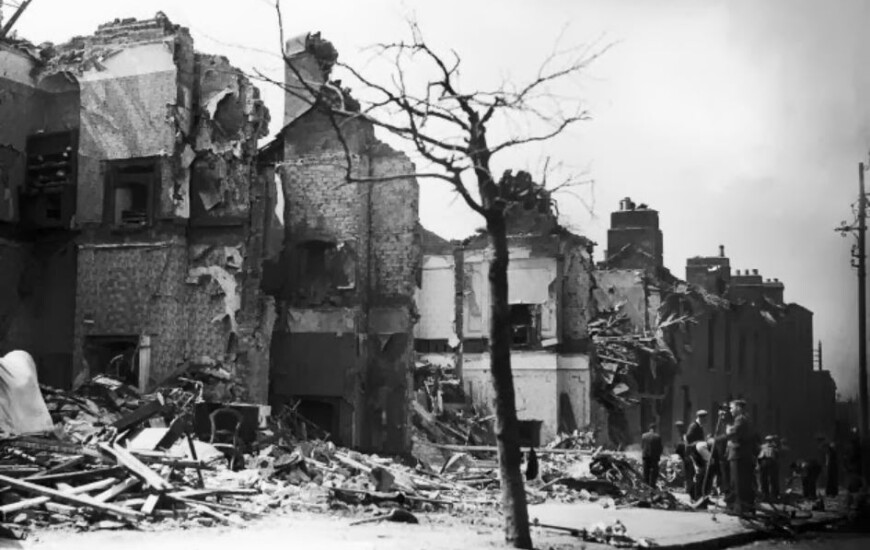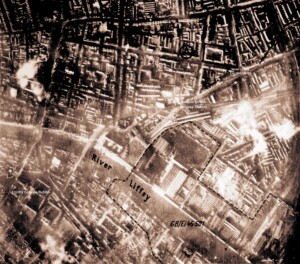Remembering lost lives: North Strand Bombing May 1941
Dublin People 29 May 2024
Peter Mulvany
On Saturday May 31, 1941 between 1.55am – 2.10 am, German bombs fell on Dublin centred in the North Strand area of the city which resulted in many casualties and damage to property.
Since then, historians have offered various reasons as to why the bombing occurred.
Likely causes from bending of radio beams by British intelligence to accidental or no accident have been proffered.
To date, no evidence has been adduced to corroborate either theory.

Luftwaffe aerial photo of Dublin City taken on December 24, 1940. This photo shows Trinity College, Amiens Street Station, Alderborough House on the North Strand marked A.
However, extracts from surviving Luftwaffe aerial photographs taken in 1940 show that Nazi Germany had acquired detailed knowledge of Dublin city and county and pinpoint with great accuracy the exact locations of military and commercial locations within the Dublin area.

Luftwaffe aerial photos of Alexander Basin-Liffey Dockyard
Of particular interest is the detail in photographs showing the Dublin port area and the Liffey dockyard.

In December 1940, when several of these pictures were taken my father, Desmond Mulvany (pictured above) originally from Whitehall in Dublin, was employed in the Liffey dockyard as an electrician degaussing British and allied vessels.
He had previously worked as an electrician in the Naval Section of the Cammell Laird Shipyard in Birkenhead.
Following a request by the Irish Government for British assistance he was brought to Dublin on secondment with a Royal Navy intelligence officer to advise the Liffey dockyard staff on the methodology of routing an electric charge through cables that had to be encircled around the hull of ships to demagnetise vessels in order to prevent activation of magnetic mines.
During WWII all sorts of mines were developed and used, sometimes complete minefields were created.
A particularly deadly variety was the magnetic mine which was engineered by German naval research into torpedo and mine fuses and they successfully developed a magnetic proximity fuse.
The magnetic mine was based on the principle that when the residual magnetism of a ship distorted the local geomagnetic field of the sensor, it activated the mine’s magnetic needle of the trigger.
One of the countermeasures was the installation of wiping stations which degaussed or demagnetised the ship’s natural magnetic field.
There is also anecdotal family evidence which suggests the German Ambassador to Ireland Eduard Hempel had become aware of what was going on in the Liffey dockyard and had been seen in the dockyard warning staff of the consequences of breaching Irish neutrality.
These aerial photographs prove beyond doubt that Hitler was targeting Irish military locations to explore vulnerabilities.
A view has been expressed that there is no extant evidence which indicates that a German invasion was being planned or imminent and that these images are only surveillance photographs which could be expected from belligerents engaged in military operations against each other.
That opinion is naive in many respects. The Luftwaffe on their flights over Ireland were not taking snaps as souvenirs for some photograph archive back in Germany.
Surveillance images which show the precise locations of military installations and commercial targets have only one purpose in a time of war and that is to seek out and identify the weaknesses and strengths of a predetermined target to overcome defences.
The multiple targeting of various Irish military installations and commercial locations within Dublin city and county by the Nazis had military objectives and it was not only just for surveillance.
Indeed, the amount of detail and precise knowledge that had been accumulated on each location within the Dublin area is very revealing and would suggest the Nazis had already acquired eyes on the ground intelligence from their agents or collaborators operating in Ireland.
It is also instructive to note that by the end of December 1940 Irish flagged neutral vessels had already been attacked and sunk by German aircraft and U-Boats with the loss of merchant seamen from Ireland, the UK, Norway and Argentina.
The North strand bombing of the 31st May 1941 was a plausible deniable Luftwaffe military incursion into Irish sovereign territory, and but for the sacrifice of UK and Allied forces which includes many Irishmen and Irishwomen, Nazi jackboots would have been marching on Dublin streets.
It has been suggested that the Luftwaffe bombing of the North Strand in 1941 was accidental, however it is more likely the German pilots missed their intended target, “THE DUBLIN DOCKS”.
The G2 conclusion re Irish public attitudes at the time may explain why the various reasons for the German bombing of the North Strand were bandied about other than the real military objective by the Germans which was to hit the Liffey Dockyard, and if the bombs went astray then plausible deniability that the bombing was accidental would have more traction with an Irish public unwilling to believe that it could have been intentional.
Interestingly the degaussing of Ships in the Liffey Dockyard ceased following the 1941 German bombing of the North Strand.
In September 1941 my father returned to the UK along with my mother and he took up a position in the Pembroke Dockyard located in Wales for the rest of the War.











